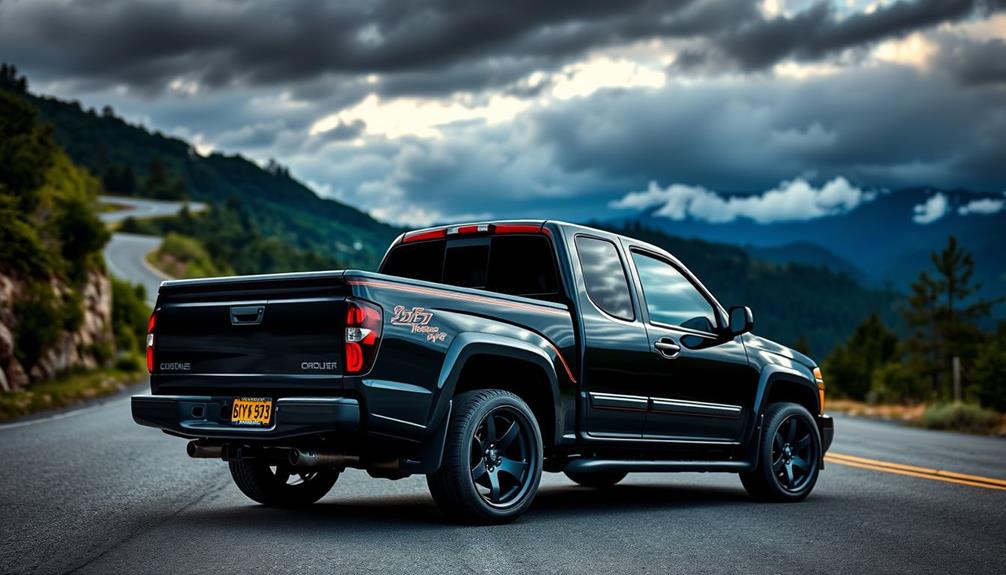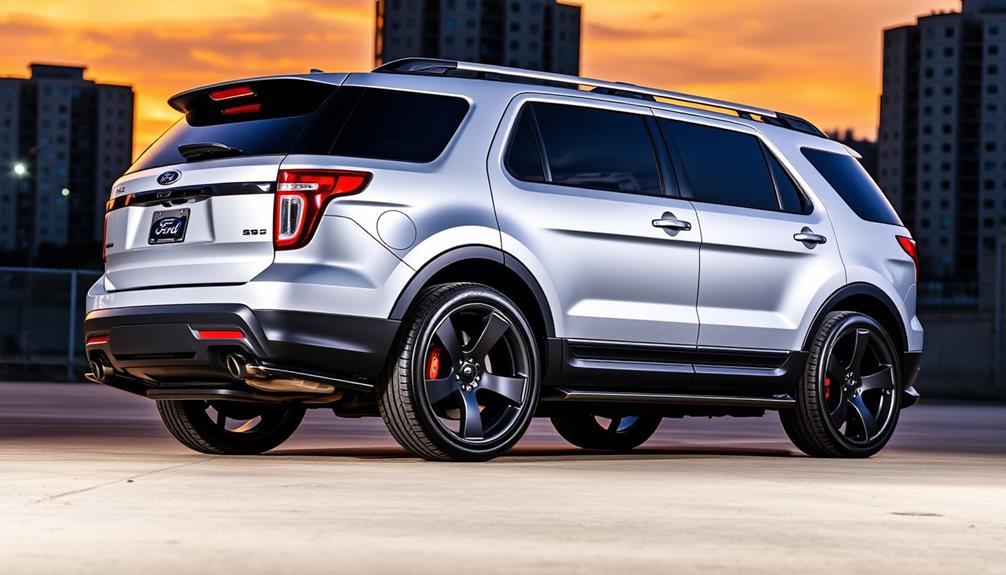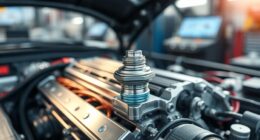Tuning your 2002 Ford Ranger can transform it into a true performance powerhouse. Start with enhancing the air intake and exhaust systems to boost horsepower and torque. Upgrading to a larger throttle body and flexible fuel injectors can improve engine response and fuel delivery. Consider performance chips for significant power gains. Keep in mind that dyno tuning is essential to maximize your upgrades and guarantee everything runs efficiently. Whether you're looking for better acceleration or overall performance, there are plenty of options to explore that will elevate your truck. Discover the best modifications to make your Ranger a standout on the road.
Key Takeaways
- Upgrade to high-performance air intake and cold air systems to boost horsepower and torque by up to 10%.
- Consider installing aftermarket throttle bodies and injectors for improved airflow and performance gains.
- Enhance exhaust flow with shorty headers and a dual exhaust system for significant power boosts.
- Dyno tuning post-modifications is essential to maximize engine efficiency and verify performance improvements.
- Explore engine swap options, like transitioning to a 5.0L V8, for a substantial increase in power and torque.
Engine Specifications Overview
When you look at the engine specifications for the 2002 Ford Ranger, you'll find that it typically comes with a 3.0L V6 engine, delivering a solid foundation for performance. This engine is rated for around 150 horsepower with stock injectors, but if you upgrade to flex fuel injectors, you can increase the flow to 220cc/min, greatly boosting performance.
Typical stock cam specifications are around 190/200, and you can explore aftermarket options to enhance your engine's capabilities further. With a thorough modification strategy, you could push the 3.0L engine's potential to approximately 200 horsepower.
To optimize airflow and overall engine output, consider investing in a cold air intake, which helps to improve the air-fuel mixture. Additionally, a larger throttle body can enhance the engine's responsiveness and performance.
Pairing these upgrades with shorty headers will further improve exhaust flow, giving your Ranger a noticeable performance boost. All these modifications work together to reveal the true potential of your 2002 Ford Ranger, transforming it into a more powerful and efficient truck.
Essential Performance Modifications
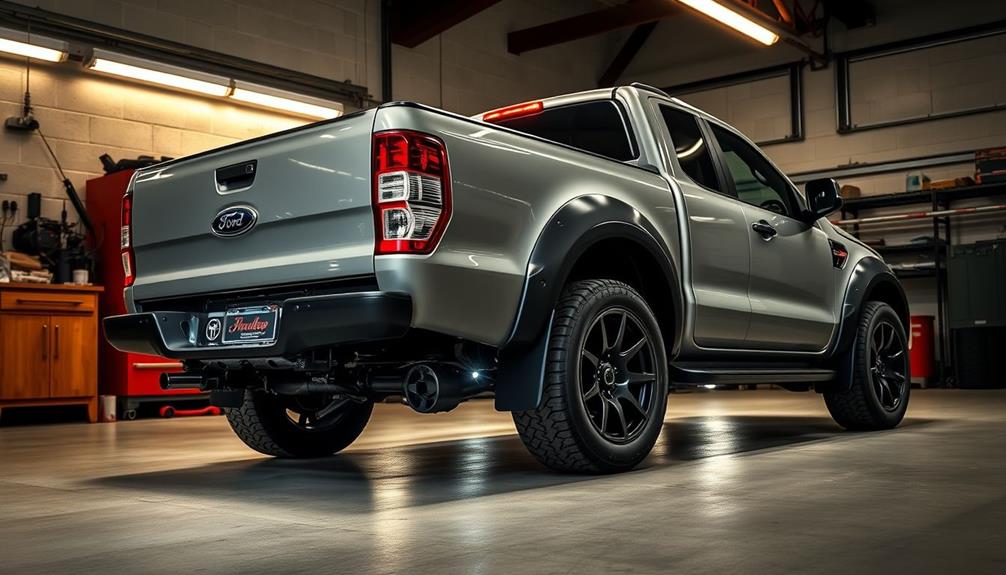
When it comes to boosting your 2002 Ford Ranger's performance, air intake upgrades and exhaust system enhancements are game changers.
A cold air intake can greatly increase horsepower, while a quality exhaust system improves airflow and reduces back pressure.
These modifications are essential for releasing the full potential of your engine.
Air Intake Upgrades
Upgrading your Ford Ranger 2002 with a high-performance air intake system can make a noticeable difference in engine performance. By installing a cold air intake, you can boost horsepower and torque by up to 10%, considerably enhancing your truck's capabilities. These air intake upgrades are designed to improve airflow, which is critical for maximizing your power output.
One of the key benefits of a performance air intake system is improved throttle response. With lightweight materials like T304 aluminum piping, you'll notice quicker acceleration and a more responsive driving experience.
Pairing this system with a larger intake air pipe supports the gains achieved through other modifications, such as a throttle body upgrade. Consider installing a 60mm throttle body from a Mustang GT to further enhance your throttle response and overall engine efficiency.
It's important to verify your MAF sensor is compatible with these upgrades for peak performance. Finally, don't forget to perform proper dyno tuning after your air intake upgrades. This step is imperative to maximizing your performance gains and achieving the power output you desire.
Transform your Ranger today and feel the difference!
Exhaust System Enhancements
Enhancing your Ford Ranger 2002's exhaust system is a crucial step toward releasing its full performance potential. By upgrading your exhaust setup, you can greatly improve horsepower and throttle response, making your truck more powerful and efficient.
Here are three key modifications to take into account:
- Shorty Headers: These improve exhaust flow, leading to a noticeable horsepower increase.
- Dual Exhaust System: This allows for more efficient expulsion of exhaust gases compared to a single system, enhancing overall power output.
- Larger Diameter Exhaust Pipe: It reduces back pressure, allowing your engine to breathe better and improving overall efficiency.
Coupling these exhaust enhancements with a performance intake manifold can yield an estimated power increase of up to 200hp in modified setups.
But don't forget, proper dyno tuning after your upgrades is crucial to maximize performance gains. This tuning guarantees your engine runs efficiently, taking full advantage of the new exhaust and intake modifications.
Community Experiences and Insights
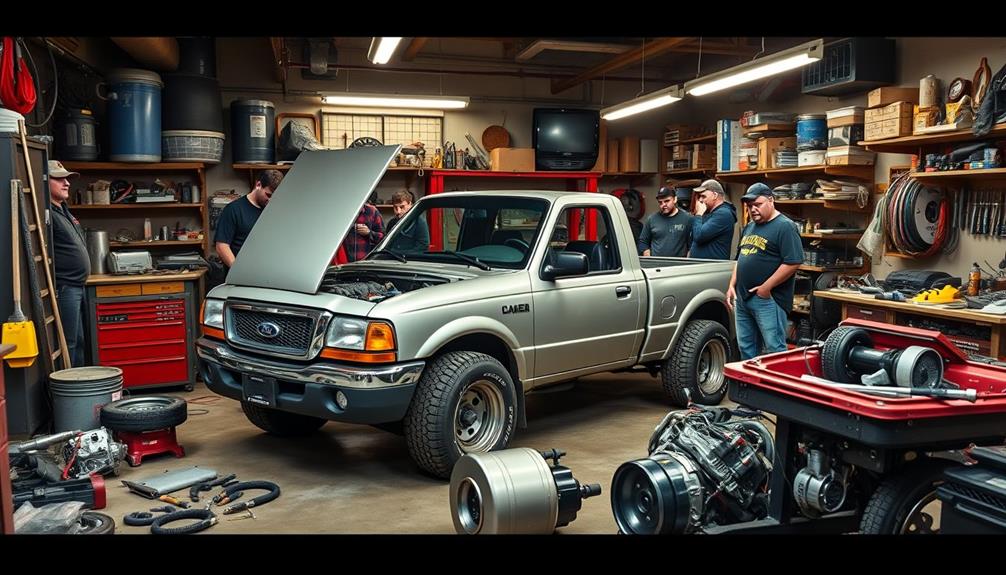
When you tune your 2002 Ford Ranger, you've likely encountered various engine swap experiences and modification challenges.
Many in the community share their expectations about performance, whether they're sticking with the 3.0L V6 or going for a V8 upgrade.
Let's compare notes on what worked, what didn't, and how you can optimize your tuning journey.
Engine Swap Experiences
Many Ford Ranger enthusiasts have shared their engine swap experiences, particularly when shifting from the stock 3.0L V6 to a more powerful 5.0L V8. The upgrade not only boosts your truck's performance but also opens the door to a world of possibilities.
Here are three key insights from the community:
- Power Increase: Swapping to a V8 engine can greatly enhance power and torque, often exceeding 200hp with the right modifications.
- Aftermarket Availability: While you can modify the 3.0L V6 for better performance, sourcing aftermarket parts for the V8 is generally easier and more plentiful.
- Suspension Upgrades: The added weight of the V8 necessitates suspension modifications to maintain ride quality and handling.
Many enthusiasts emphasize that creativity and a solid modification strategy are essential when sticking with the 3.0L engine, yet many find the V8 experience transformative.
The thrill of driving a performance-enhanced Ranger with a V8 engine often outweighs the challenges faced during the swap. Embrace the journey and enjoy the ride!
Modification Challenges Faced
Frequently, Ford Ranger owners encounter significant modification challenges, especially when working with the stock 3.0L engine. One of the main frustrations within the community is the limited availability of aftermarket parts for this specific engine. Many enthusiasts find themselves fabricating custom parts, like larger intake pipes and custom exhaust systems, to improve airflow and overall performance.
Sourcing specific performance components can be an intimidating task, particularly when compared to the more popular V8 options that have a wider range of aftermarket support. This scarcity often pushes some owners to explore engine swaps to achieve greater power potential.
Moreover, substantial modifications typically require extensive mechanical knowledge and creativity, which can be overwhelming for newcomers. However, many community members highlight that these challenges present valuable learning experiences. Each project not only enhances your truck's performance but also helps you gain a deeper understanding of automotive tuning and modification techniques.
Navigating these obstacles might be tough, but the satisfaction that comes from overcoming them can make the journey worthwhile for any dedicated Ford Ranger enthusiast.
Performance Expectations Discussed
Steering through the challenges of modifying a Ford Ranger's 3.0L engine leads to a range of performance expectations among enthusiasts. Here's what you can realistically aim for:
- Power Gains: After significant upgrades, like cold air intakes and performance exhaust systems, you can achieve around 170hp at the wheels.
- Maximized Potential: With extensive modifications, including larger throttle bodies, some enthusiasts target power outputs of up to 200hp.
- Engine Swaps: Many users highlight the substantial performance improvements when swapping to a 5.0L V8, showcasing the limitations of the stock OHV engine.
Community experiences emphasize the importance of dyno tuning after modifications to guarantee peak engine efficiency. This step is essential for maximizing your intake and exhaust performance.
You'll find that while sourcing aftermarket parts for the 3.0L engine can be challenging, a creative approach can still yield impressive results. Engage with fellow enthusiasts, share insights, and explore various tuning techniques to release your Ford Ranger's full potential.
The journey may be tough, but the rewards can transform your truck into a performance powerhouse.
Challenges With Engine Tuning
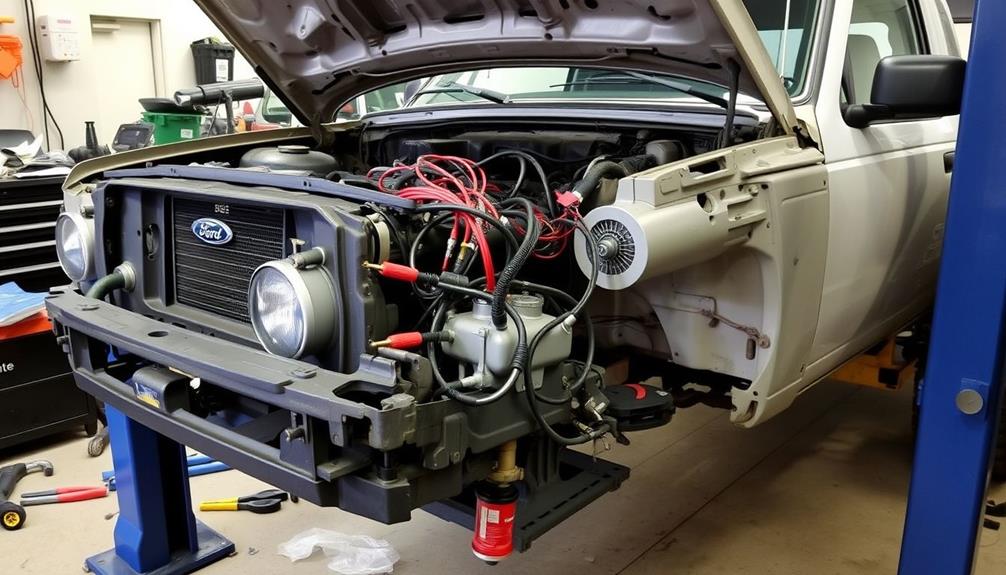
When diving into the world of engine tuning for a 2002 Ford Ranger with a 3.0L V6, you'll quickly encounter several challenges that can test your skills and creativity. One major hurdle is the limited availability of aftermarket parts. You may need to get creative and fabricate components to achieve the upgrades you desire.
Additionally, performance modifications like upgrading injectors or installing shorty headers require careful calibration to avoid compromising the reliability of your engine.
Another challenge arises from the original camshaft specifications, which are around 190/200. If you want to make much of a power gain, you'll likely need to replace the camshaft with an aftermarket option, complicating your tuning efforts.
Dyno tuning is essential after making these modifications to guarantee peak performance, but keep in mind that it can be costly and requires specialized equipment and expertise.
If you're considering an engine swap—like going for a more powerful V8, similar to what you might find in a Mustang GT—be prepared for even more challenges. This swap can lead to suspension wear and the need for compatible components, further complicating the tuning process.
Expected Performance Gains

Tuning your 2002 Ford Ranger with a 3.0L V6 can lead to impressive performance gains that transform your driving experience. By making the right modifications, you can achieve around 170 horsepower at the wheels, which markedly enhances your truck's capabilities.
Here are three key upgrades that can maximize your performance:
- Cold Air Intake System: Installing this system can boost horsepower and torque by up to 10%, giving your engine a more robust performance.
- 60mm Mustang GT Throttle Body: Upgrading to this throttle body improves throttle response, resulting in quicker acceleration and better overall driving dynamics.
- Aftermarket Camshaft: Opting for a camshaft like the Comp Cams 49-422-8 can enhance mid-range torque, making your Ranger more responsive during acceleration.
Don't forget that proper dyno tuning after these modifications is essential. It not only optimizes the performance gains but also guarantees that your engine runs smoothly and reliably with the new components.
With these upgrades, your Ranger won't only roar to life but also provide a thrilling driving experience every time you hit the road.
Engine Block and Head Options

Upgrading the engine block and heads on your 2002 Ford Ranger can greatly enhance performance and reliability. The factory 3.0L V6 engine can benefit from aftermarket cylinder heads, which improve airflow and reduce the risk of cracking. Consider that early blocks (1990-1994) allow for a .048 overbore, while later models (1995-2000) are limited to a .030 overbore due to material changes.
Here's a quick comparison table for reference:
| Component | Standard Specs | Aftermarket Upgrade |
|---|---|---|
| Engine Type | 3.0L V6 | 4.0L V6 Compatibility |
| Standard Bore Size | 3.952 inches | Up to .048/.030 overbore |
| Performance Improvement | Moderate | Significant |
| Airflow Enhancement | Stock | Enhanced |
| Reliability | Average | Improved |
Camshaft and Throttle Body Choices

Boosting performance on your 2002 Ford Ranger is achievable with the right camshaft and throttle body choices. Selecting the right components can greatly enhance your truck's power and responsiveness. Here are three top choices to take into account:
- Comp Cams 49-410-8: This camshaft operates effectively in the 800-4,800 RPM range, providing a boost in torque and improved mileage.
- Comp Cams 49-422-8: Ideal for those seeking strong mid-range torque, this camshaft works well in the 1,200-5,200 RPM range.
- Throttle Body Options: Upgrading to a 60mm Mustang GT throttle body can greatly enhance throttle response when paired with a modified intake system, while the 66mm BBK throttle body maximizes airflow for peak power output.
While tuning isn't strictly necessary for camshaft installations, it's highly recommended to verify compatibility with other engine modifications and achieve the best attainable performance gains.
Injector and MAF Selection

When tuning your 2002 Ford Ranger, choosing the right injector size is essential for enhancing performance and maintaining smooth idle.
You'll also need to take into account MAF compatibility to guarantee your upgrades work seamlessly together.
Getting these selections right can greatly impact your engine's efficiency and power output.
Optimal Injector Sizing
To achieve ideal performance in your 2002 Ford Ranger, selecting the right injector size is essential. Using 24lbs injectors for the 3.0L engine is highly recommended, as they support better idle and can push your truck to around 370rwhp on similar setups.
However, remember that upgrading injectors often means you'll need to recalibrate or tune your engine to guarantee it runs efficiently and maximizes power output.
Here are three key points to reflect on when choosing injectors:
- Power Goals: Make sure your injector size aligns with your intended power goals. Larger injectors can disrupt fuel delivery if not properly tuned.
- MAF Compatibility: Think about using a C&L MAF, which allows for easy sampling tube updates when installing larger injectors, optimizing airflow management.
- Recalibration Needs: After installing upgraded injectors, always recalibrate your system to maintain efficiency and enhance overall performance.
MAF Compatibility Considerations
Selecting the right Mass Airflow (MAF) sensor is vital for enhancing your 2002 Ford Ranger's performance, especially when upgrading components like injectors. For your Ranger, consider using the 80mm MAF from the 1999-2004 Mustang GT, which is suitable for 4.0 OHV applications. This choice will enhance airflow, supporting your performance goals.
When you upgrade your injectors to larger sizes, such as 24lbs injectors, you'll likely see improvements in idle and overall performance. However, be aware that these larger injectors will require recalibration or tuning for peak functionality. The EEC5 systems in your Ranger can be recalibrated to work with these injectors, but it's important to get a dyno tune after making any upgrades to verify everything functions harmoniously.
Avoid using calibrated MAFs, as they can disrupt your engine's electronics and lead to performance issues instead of enhancements.
It's vital to confirm compatibility between your chosen injectors and MAF sensors; mismatched components can hinder performance improvements and negatively affect your vehicle's efficiency. Making informed choices here will help you achieve the performance powerhouse you want.
Tuning Techniques for Optimization

How can you access the full potential of your 2002 Ford Ranger? By implementing some effective tuning techniques, you'll transform your truck into a performance powerhouse.
Here are three key upgrades to take into account:
- Cold Air Intake & Performance Intake Manifold: These enhancements improve airflow and throttle response, making your engine more responsive.
- 60mm Mustang GT Throttle Body: Upgrading to this throttle body enhances throttle response, allowing for better acceleration and overall engine performance.
- Shorty Headers & Dual Exhaust System: This combination increases power output by improving exhaust flow and reducing back pressure.
After you've made these changes, don't forget about dyno tuning. It's essential to verify that your engine operates efficiently and to maximize the performance gains from your upgrades.
You might also want to think about aftermarket camshafts like Comp Cams to further enhance torque and horsepower, keeping your engine in its best powerband.
Performance Chip Options Available

Releasing your 2002 Ford Ranger's performance potential is easier than ever with a variety of performance chip options. One popular choice is the Stage 1 Performance Chip Module OBD2, priced at $99.99. This chip uses advanced OBD-2 technology to reveal hidden engine power while providing a safe, plug-and-play installation.
If you're after a more significant boost, consider the Stage 3 Performance Chip OBDII Module for $239.95. It maximizes engine performance with a next-generation multi-core CPU and requires no cutting for installation.
For those who want a thorough solution, the Stage 4 Performance Chip Module OBD2 is available at $299.95. It includes an LCD monitor and offers 3-in-1 functionality, specifically designed for Ford models from 2005 onward.
With these chips, you can expect an increase of up to 15-20 horsepower and 25-30 lb-ft of torque, dramatically improving your Ranger's acceleration and overall performance.
Additionally, tuning options like the Economy Tune and Diablo Tune allow you to customize settings to achieve specific horsepower and torque gains, enhancing both fuel economy and performance for your driving needs.
Frequently Asked Questions
How Much HP Can a Ford Ranger Make?
A Ford Ranger can produce varying horsepower based on modifications. Stock engines typically generate around 150 hp, while with upgrades, you might achieve 170 hp or even over 300 hp with extensive tuning and enhancements.
How to Make a 4.0 Ranger Faster?
You won't believe how easy it is to make your 4.0 Ranger faster. Upgrading your intake, throttle body, and exhaust system, plus tuning, can release significant power and transform your ride into a speed machine.
How Much Power Does a 4.0 Ranger Make?
A stock 4.0 Ranger typically produces around 130-145 rwhp. With performance upgrades, you can push that to 250-275 rwhp, and turbocharging can even exceed 300 rwhp, greatly boosting your truck's performance.
How to Make a Ford Ranger 2.3 Faster?
Think of your Ford Ranger 2.3 as a racehorse waiting to gallop. You'll boost speed by upgrading the intake system, optimizing exhaust flow, and fine-tuning with performance injectors—then watch it fly down the road.
Conclusion
In the end, tuning your 2002 Ford Ranger is like giving a good friend a much-needed makeover—transformative and exhilarating. Just like that friend who blossoms with confidence after a fresh style, your Ranger can roar to life with the right modifications. Picture yourself cruising down the highway, feeling the rush of power beneath you, knowing you've turned your trusty truck into a performance powerhouse. So, roll up your sleeves and get ready to release its true potential! If you’re ready to take on the challenge of tuning your 2002 Ford Ranger, here are a few important ford ranger tuning tips to keep in mind. Firstly, consider upgrading your air intake and exhaust systems to improve airflow and increase horsepower. Additionally, investing in a quality tuner or performance chip can help optimize your engine’s performance and fuel efficiency. Lastly, don’t forget to regularly maintain and tune up your Ranger to ensure it continues to perform at its best. With these ford ranger tuning tips in mind, you’ll be well on your way to unlocking your truck’s full potential.

